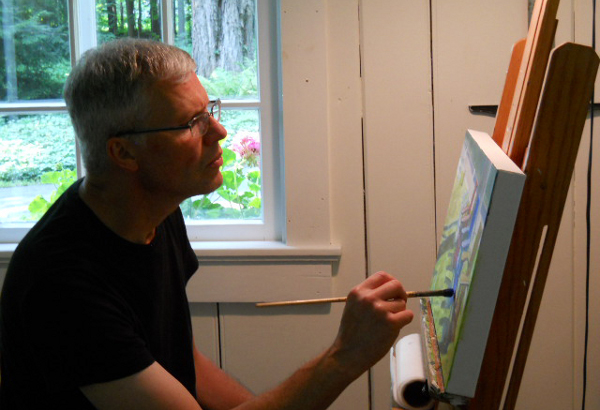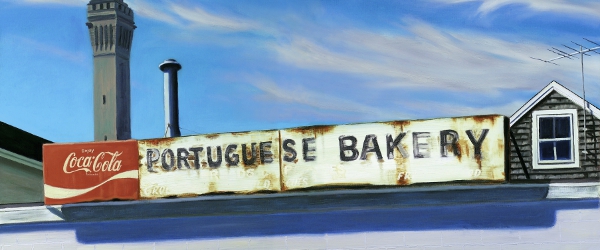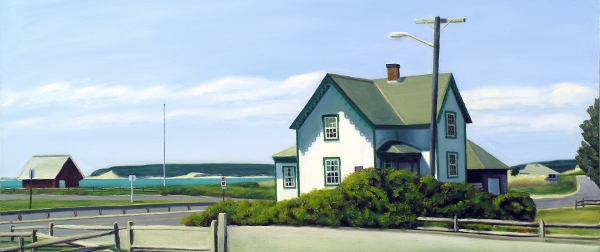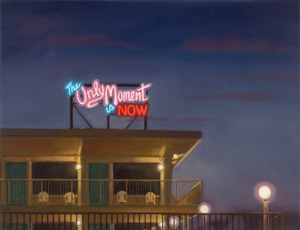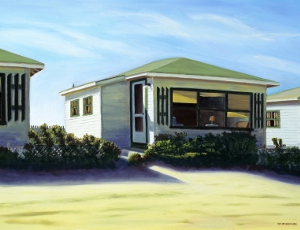Published 13/08/2014
Bridgeman Studio artist, David Arsenault, has been a part of the Bridgeman community for almost a decade.
We had the opportunity to ask David a few questions about his life and practice as a painter, and how he initially came to Bridgeman to license his work.
What is your earliest memory of an artwork and who was it by?
I recall first being mesmerized by an artist's creation in 1970, when I discovered a reproduction of Edward Hopper's painting 'Gas' in a grade school library book. I took the book out many times so that I could see it again and again. But it wasn't until the early 1990's, more than twenty years later, that a professor in my graphic arts program reintroduced me to Hopper's work, and it was then I decided to study painting.
What is your favorite time of day to be in your studio?
I'm often the most productive in the morning. However, the best light in my studio is in the afternoon, and so that's when I see best and get the truest look at the colors I'm mixing and adding to the painting on my easel.
Talk us through a day in the studio of David Arsenault. What is your routine?
Most days I begin by adding a post to my Facebook page The Art of David Arsenault. I upload an image of a painting and share something about it that I think may be of interest to others.
Once in the studio, I assess from a distance the canvas on the easel: what works and what doesn't, what needs to be added or changed, how do the colors and composition flow? I'll often jot down notes to be sure I don't forget what needs to be done, and then get to work from there.
Most of the time I'll keep a single painting going until it's nearly finished. When almost finished, I'm ready for something new. The movements and decisions involved in shaping a blank rectangle are vastly different and much looser than finishing a painting. Typically I'll spend between 6 and 8 hours in the studio—parallel to a standard business day—before cleaning my brushes and closing the door.
How would you sum up your practice in 3 words?
Paint what inspires.
What did you spend your first art-sale pay check on and how did you feel?!
The year would have been 1995, and my first sale was for $100. But I can't honestly say I remember what I used the money for. I did just recently have contact with that first collector, and she said she still loves the painting. That feels great, knowing it's still appreciated nearly twenty years later.
Your paintings illuminate such light into ordinary day-to-day scenes. How do you choose a location or subject for a piece? What is your favorite location to work from?
After a "seeing" excursion, I need time to process and internalize what I've seen, and to review the photos I may have taken to remind myself of what I was excited by. It's hard to describe why I paint the things I do, but if what I see doesn't hit me in a powerful way, it won't end up on canvas.
Presently I'm almost single-mindedly exploring Cape Ann, Massachusetts, specifically Rockport and Gloucester, seaside communities where artists have been inspired to work for decades. As for the painting process itself, it always takes place in the studio regardless of where inspiration strikes. I'm not a 'en plein air' painter.
Which other artists, dead or alive would you choose to have dinner with?
First and foremost it would have to be Edward Hopper. His work has captivated and influenced me more than anyone else. Seeing his paintings made it seem almost as if he was directly expressing what I felt inside. As much as he was deemed an introvert and difficult, I would want to try to get him to open up, to really articulate not only what he was searching for, but where it was coming from.
Others on my list might include Wayne Thiebaud, Fairfield Porter, and George Tooker.
What brought you to Bridgeman for the licensing of your artwork?
Bridgeman did. In 2005, I received an email from Account Manager, Tom Haggerty, asking if I would be interested in an associating with what was then, The Bridgeman Art Library. Next year will be the ten-year anniversary of this partnership.
See all of David Arsenault's images available for licensing

